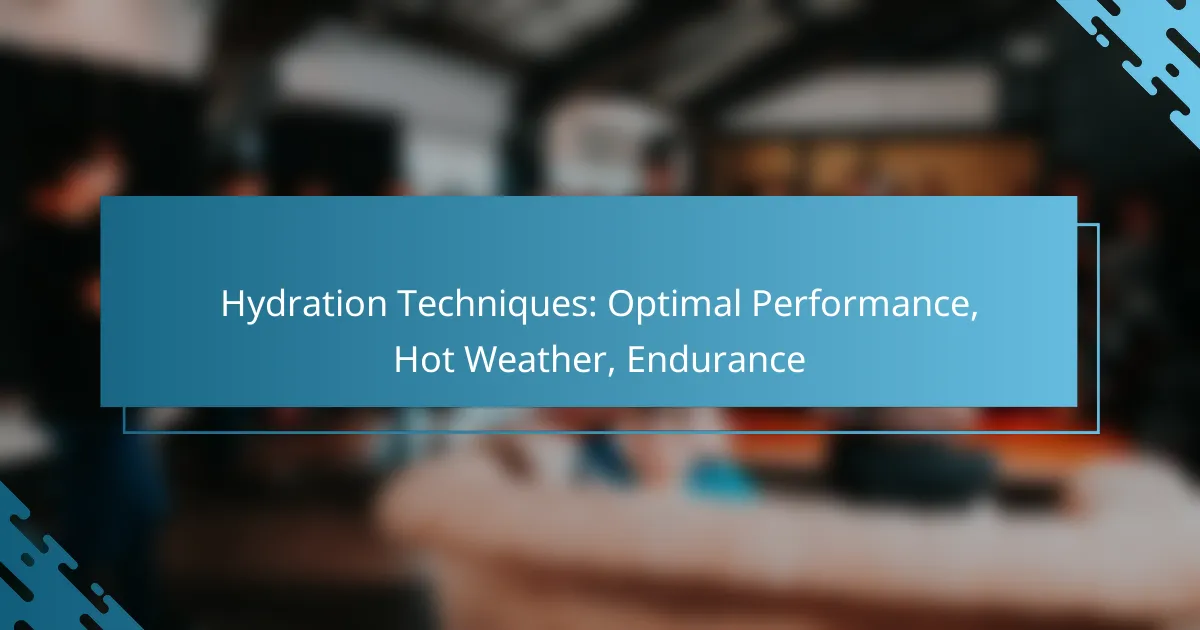Hydration is crucial for optimal performance, particularly in hot weather and endurance activities. Employing effective techniques, such as consuming electrolyte-rich beverages and timing water intake, can significantly enhance athletic performance and prevent dehydration. As temperatures rise, understanding and implementing these hydration strategies becomes essential for maintaining fluid balance and supporting overall endurance.
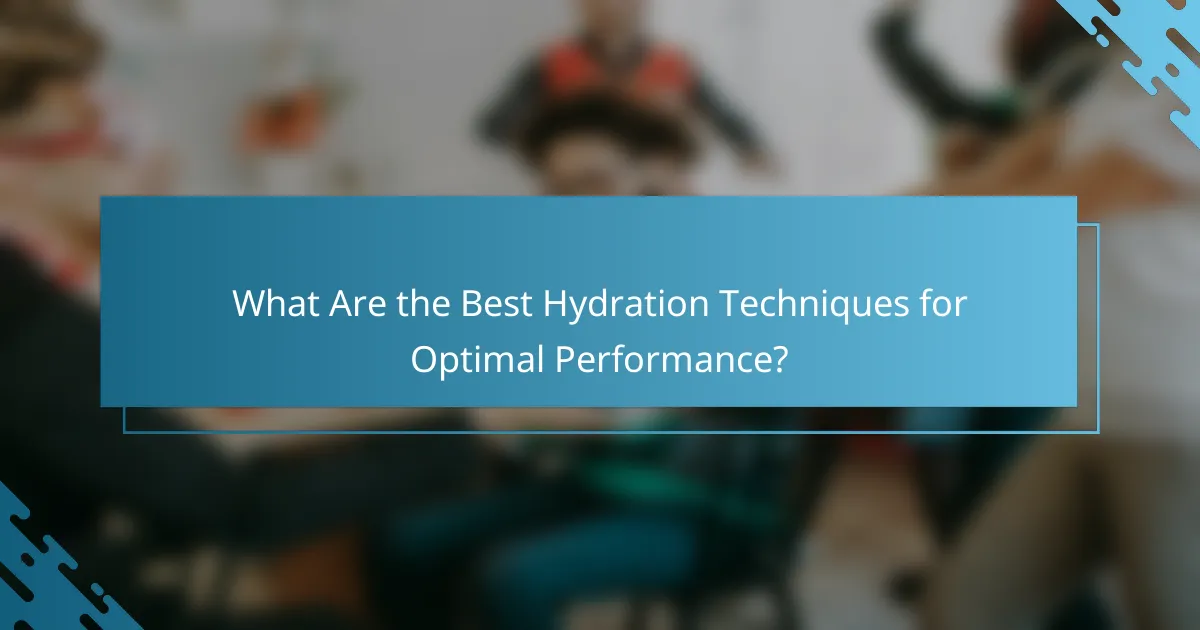
What Are the Best Hydration Techniques for Optimal Performance?
The best hydration techniques for optimal performance involve a combination of electrolyte-rich beverages, effective water intake strategies, and proper timing of hydration. These methods help maintain fluid balance, enhance endurance, and support overall athletic performance, especially in hot weather conditions.
Electrolyte-rich beverages
Electrolyte-rich beverages are essential for replenishing lost minerals during prolonged physical activity. Drinks containing sodium, potassium, and magnesium can help prevent dehydration and muscle cramps. Look for options with a balanced ratio of electrolytes and carbohydrates to support energy levels during endurance activities.
Common choices include sports drinks, coconut water, and electrolyte tablets that can be mixed with water. Aim for beverages that contain around 300-600 mg of sodium per liter to effectively replace what is lost through sweat.
Water intake strategies
Effective water intake strategies involve drinking water consistently throughout the day rather than consuming large amounts at once. A good rule of thumb is to drink about 500-750 ml of water two hours before exercise and continue to hydrate during and after the activity.
Consider using a water bottle with measurements to track your intake. For endurance activities lasting over an hour, aim for an additional 200-300 ml of water every 20-30 minutes to maintain hydration levels.
Timing of hydration
Timing your hydration is crucial for optimal performance. Begin hydrating well before exercise, ideally starting the day before an event, to ensure your body is adequately prepared. During exercise, drink at regular intervals to prevent dehydration.
Post-exercise hydration is equally important. Aim to consume 1.5 liters of fluid for every kilogram of body weight lost during activity to help recover fluid balance effectively.
Hydration tracking tools
Hydration tracking tools can help you monitor your fluid intake and ensure you are meeting your hydration goals. Apps and smart water bottles can provide reminders and track consumption throughout the day.
Additionally, consider using a simple urine color chart to assess hydration status. Pale yellow urine typically indicates proper hydration, while darker shades suggest a need for increased fluid intake.
Personalized hydration plans
Creating a personalized hydration plan involves assessing your individual needs based on factors like body weight, activity level, and environmental conditions. Tailor your hydration strategies to match your specific requirements for optimal performance.
Consulting with a sports nutritionist can provide insights into your hydration needs, helping you develop a plan that includes specific fluid and electrolyte targets based on your training intensity and duration.

How Does Hot Weather Affect Hydration Needs?
Hot weather significantly increases hydration needs due to higher fluid loss from sweating. As temperatures rise, the body works harder to cool itself, leading to a greater requirement for water and electrolytes to maintain optimal performance and prevent dehydration.
Increased fluid loss through sweat
In hot conditions, the body can lose substantial amounts of fluid through sweat, often exceeding several liters per hour during intense activity. This fluid loss is the body’s primary mechanism for regulating temperature, but it can lead to dehydration if not adequately replaced.
Factors such as humidity, exercise intensity, and individual sweat rates can influence how much fluid is lost. Athletes and outdoor workers should be particularly mindful of these variables to ensure they stay properly hydrated.
Signs of dehydration in heat
Common signs of dehydration in hot weather include thirst, dry mouth, fatigue, dizziness, and reduced urine output. More severe symptoms can manifest as confusion, rapid heartbeat, and fainting.
It’s crucial to monitor these signs, especially during prolonged exposure to heat or intense physical activity. Early recognition can help prevent more serious health issues related to dehydration.
Recommended fluid intake in hot climates
In hot climates, a general guideline is to consume at least 2 to 3 liters of water per day, with higher amounts recommended for those engaging in physical activities. Adjustments should be made based on sweat loss, exercise duration, and environmental conditions.
Electrolyte-rich drinks can also be beneficial, especially after extended periods of sweating. A practical approach is to drink small amounts regularly rather than waiting until thirst sets in, ensuring consistent hydration throughout the day.

What Hydration Strategies Are Effective for Endurance Events?
Effective hydration strategies for endurance events focus on maintaining fluid balance before, during, and after the activity. Proper hydration can significantly enhance performance, especially in hot weather conditions where the risk of dehydration increases.
Pre-event hydration protocols
Prior to an endurance event, it’s crucial to start hydrating well in advance, ideally 24-48 hours before the race. Aim for about 500-600 mL of water or an electrolyte drink two to three hours before the start to ensure optimal hydration levels.
Monitor your urine color as a simple gauge; pale yellow indicates good hydration, while darker shades suggest a need for more fluids. Avoid excessive caffeine or alcohol, as they can lead to dehydration.
During-event hydration practices
During the event, aim to consume 400-800 mL of fluid per hour, depending on the intensity and environmental conditions. Sports drinks containing electrolytes are beneficial for longer events, as they help replenish lost salts and maintain energy levels.
Establish a routine for hydration breaks, such as drinking every 15-20 minutes. This helps prevent dehydration and maintains performance. Use aid stations effectively, but also consider carrying a personal hydration system for convenience.
Post-event recovery hydration
After completing an endurance event, rehydration is essential for recovery. Aim to drink 1.5 times the amount of fluid lost during the event within the first few hours. This can be achieved through water or electrolyte-rich beverages.
Incorporate foods with high water content, such as fruits and soups, to aid in rehydration. Pay attention to your body; if you feel thirsty or fatigued, continue to hydrate until you feel fully recovered.
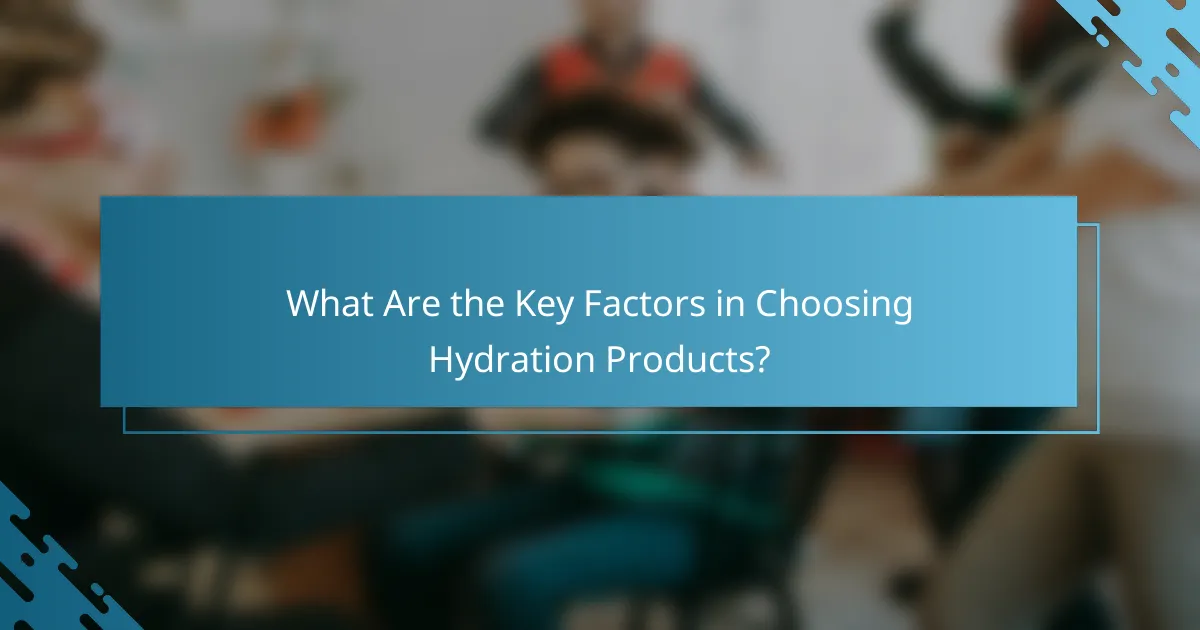
What Are the Key Factors in Choosing Hydration Products?
When selecting hydration products, consider factors such as ingredient composition, brand reputation, and cost-effectiveness. These elements significantly influence hydration efficiency, taste, and overall value for your needs, especially during intense activities or hot weather.
Ingredient analysis
Examine the ingredients in hydration products to ensure they meet your hydration needs. Look for essential electrolytes like sodium, potassium, and magnesium, which help maintain fluid balance and support muscle function. Avoid products with excessive sugars or artificial additives, as they can hinder hydration and overall performance.
For optimal hydration, consider products that contain a balanced ratio of carbohydrates to electrolytes, typically around 6-8% carbohydrate content. This balance helps enhance absorption and provides sustained energy during endurance activities.
Brand comparisons
Different brands offer various hydration products, each with unique formulations and benefits. Popular brands often have established reputations for quality and effectiveness, making them a safer choice. Research customer reviews and expert opinions to gauge performance and taste preferences.
Compare brands based on their ingredient transparency and certifications, such as NSF Certified for Sport, which ensures that products are free from banned substances. This can be particularly important for competitive athletes who need to adhere to strict regulations.
Cost-effectiveness
Cost-effectiveness is a crucial factor when choosing hydration products, especially for regular use. Evaluate the price per serving and consider bulk purchasing options to reduce costs. Many brands offer subscription services or discounts for larger quantities, which can lead to significant savings over time.
Additionally, consider the performance benefits relative to the price. A higher-priced product may be justified if it provides superior hydration and energy during workouts, ultimately enhancing your performance and recovery.
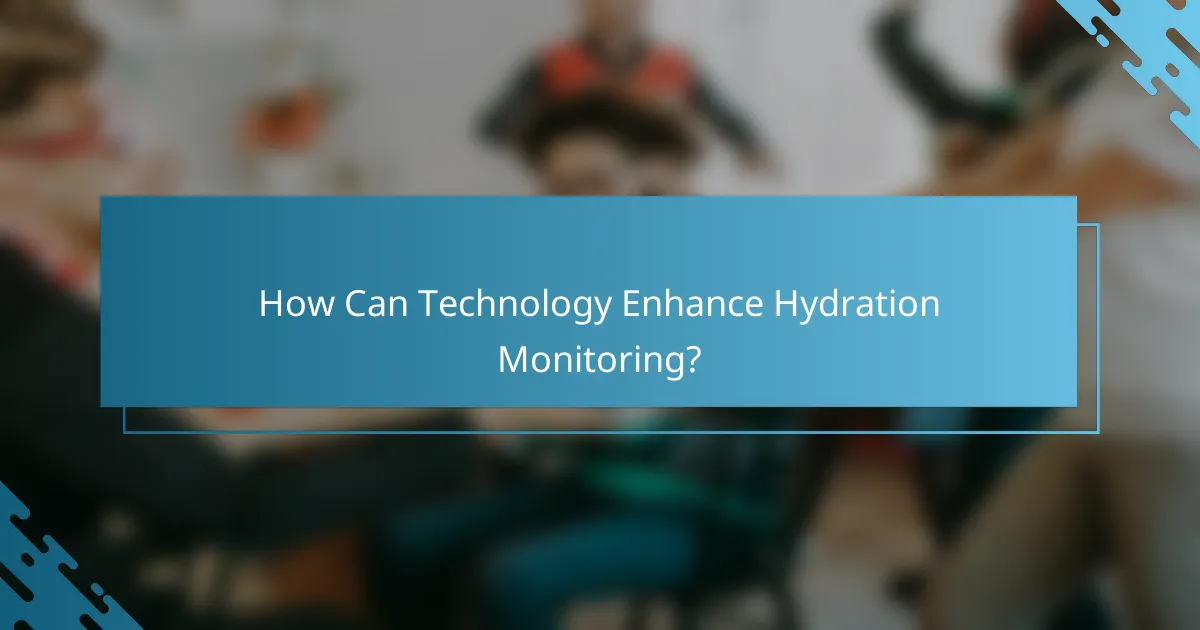
How Can Technology Enhance Hydration Monitoring?
Technology can significantly improve hydration monitoring by providing real-time data and reminders to help individuals maintain optimal fluid intake. By utilizing wearable devices and mobile applications, users can track their hydration levels and receive alerts tailored to their personal needs.
Wearable hydration trackers
Wearable hydration trackers are devices that monitor fluid levels in the body, often through sweat analysis or skin temperature. These gadgets can provide insights into hydration status and suggest when to drink more fluids, especially during intense physical activities or hot weather.
When choosing a wearable hydration tracker, consider features such as battery life, accuracy, and compatibility with other fitness devices. Popular options include smartwatches and fitness bands that integrate hydration tracking into their overall health monitoring capabilities.
Mobile apps for hydration reminders
Mobile apps designed for hydration reminders help users stay on top of their fluid intake by sending notifications at set intervals. These applications often allow users to log their water consumption and set daily goals based on their activity level and environmental conditions.
Look for apps that offer customizable reminders, easy logging features, and integration with other health apps. Some popular hydration apps include MyWater and WaterMinder, which provide user-friendly interfaces and helpful statistics to encourage consistent hydration habits.
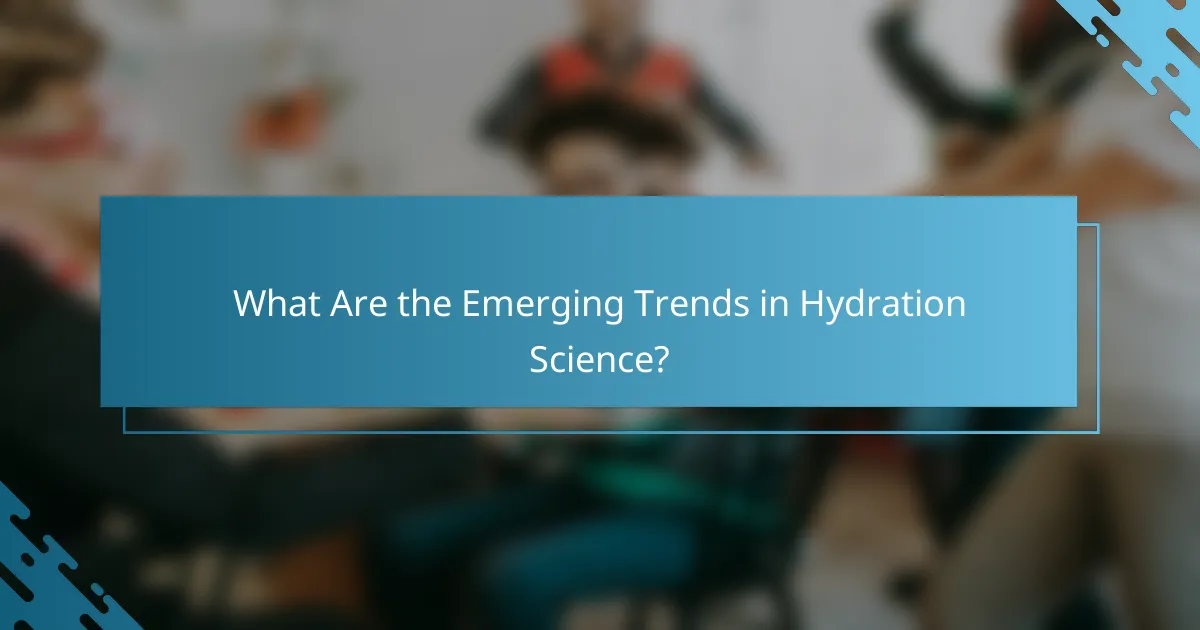
What Are the Emerging Trends in Hydration Science?
Emerging trends in hydration science focus on personalized hydration strategies, the use of advanced technology for monitoring fluid intake, and the incorporation of electrolytes to optimize performance. These trends emphasize the importance of understanding individual hydration needs based on activity levels, environmental conditions, and physiological responses.
Personalized Hydration Strategies
Personalized hydration strategies are becoming increasingly popular as they take into account individual factors such as body weight, exercise intensity, and climate. Athletes are encouraged to monitor their hydration status through methods like urine color assessment or sweat testing to determine their specific fluid needs.
For example, a common guideline suggests consuming about 500-700 mL of fluid for every hour of intense exercise, but this can vary significantly based on personal sweat rates. Tailoring hydration plans can enhance performance and recovery, especially in hot weather or during endurance events.
Technology in Hydration Monitoring
Advancements in technology have led to the development of smart hydration devices that track fluid intake and loss in real-time. Wearable devices can measure sweat rates and provide feedback on hydration levels, allowing users to adjust their fluid intake accordingly.
These devices can be particularly useful for athletes training in extreme conditions, helping them maintain optimal hydration without guesswork. However, reliance on technology should be balanced with personal awareness of hydration cues, such as thirst and fatigue.
Electrolyte Incorporation
Incorporating electrolytes into hydration plans is gaining traction, especially for endurance athletes. Electrolytes like sodium, potassium, and magnesium help maintain fluid balance and prevent cramping during prolonged physical activity.
Sports drinks or electrolyte tablets can be beneficial, particularly in hot environments where sweat loss is significant. A practical approach is to consume a beverage containing 500-700 mg of sodium per liter of water during extended exercise sessions to replace lost electrolytes effectively.
